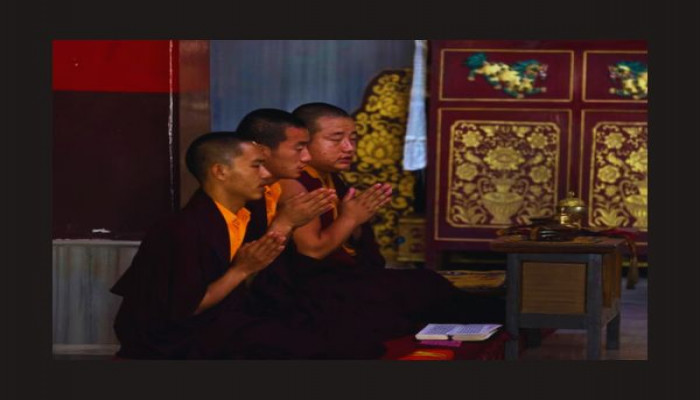India overhauls curriculum of Himalayan Buddhist Monasteries to curb Chinese influence
- In Reports
- 07:38 PM, Apr 08, 2025
- Myind Staff
In a landmark move aimed at harmonising education and asserting national identity in border regions, India is preparing to launch its first standardised school curriculum for Buddhist monasteries across the Himalayan belt. This initiative is part of a broader strategy to counter Chinese influence in religious institutions situated near the contested Indo-China frontier.
The curriculum, set to roll out this month, will be implemented initially in about 20 monasteries located along India’s 3,000-km border with China. These monasteries are found in northern states and union territories such as Sikkim, Himachal Pradesh, Uttarakhand, Jammu and Kashmir, and Ladakh. Over time, the rest of India’s 600-odd monasteries in these regions will also adopt the curriculum.
National Education Meets Religious Tradition
India, a country deeply rooted in Buddhist heritage and home to ancient monasteries, saw a resurgence of Buddhist institutions after thousands of Tibetan refugees arrived during the 1950s, fleeing Chinese control. However, New Delhi now aims to insulate religious learning from external influences, especially China’s.
“We are trying to inculcate Indian identity through education along with Buddhism to make sure China can never control our monasteries in the Himalayas,” said Maling Gombu, a Buddhist worker affiliated with the ruling Bharatiya Janata Party (BJP). Gombu is part of a team promoting Indian Buddhist traditions and implementing national educational standards in states like Arunachal Pradesh, which China claims as its own but is administered by India.
According to Gombu, thousands of children living and studying in remote monasteries deserve a nationally recognised education that prepares them for life outside monastic institutions. This vision underpins the government’s efforts to bring a structured syllabus into monastic education.
Filling the Gaps in Monastic Education
Currently, monasteries offer instruction in four Tibetan and Indian Buddhist traditions and also teach modern subjects and English. However, there is no uniform curriculum or recognition outside the monasteries.
“The non-religious education taught by monks or nuns is not acknowledged outside monasteries,” said Rajeev Kumar Singh, Director at the National Institute of Open Schooling under the Ministry of Education. Singh has overseen the five-year effort to draft the new curriculum and explained that it aims to help both Indian and Tibetan students adapt academically and professionally.
“They (Tibetans) are free to learn Tibetan history and their tradition, but they should learn about India as they reside here and require proper education to secure jobs outside monasteries,” he said.
Reuters reviewed the first set of textbooks produced by the education ministry in collaboration with Indian Buddhist scholars. These books focus on India's ancient and modern history, its role in the Tibetan freedom struggle, and include subjects like mathematics, science and computer education. The curriculum also mandates instruction in English, Hindi and Bhoti — a language commonly spoken in Himalayan Buddhist communities.
Challenges and Resistance
Despite the structured approach, the process of implementing the new syllabus comes with logistical and ideological challenges. The government is still negotiating individually with monastery leaders, sourcing qualified teachers, and printing new educational materials for institutions in remote areas.
At Gontse Garden Rabgye Ling Monastery in Arunachal Pradesh, some resistance has emerged. Geshe Dondup, a senior religious instructor at the monastery, which currently has around 300 students, voiced concerns over the new plan.
“We don’t think introduction of government-mandated syllabus is required in our monastery as it can break the rhythm designed since the 1970s,” Dondup said, emphasising that their current curriculum already balances Buddhist philosophy with modern education.
This response highlights the sensitivity involved in balancing religious autonomy with state educational policies.
Political and Strategic Dimensions
India’s broader strategic concerns underpin the initiative. A senior Home Ministry official, speaking anonymously, said the curriculum reform is part of a wider effort to shield Himalayan religious institutions from Chinese influence.
The region remains geopolitically tense. Although India and China have begun scaling down their military presence along the disputed border, following deadly clashes in 2020 that killed more than 20 soldiers, India continues to prioritise development and national integration in border areas.
In a parallel move last year, India’s judiciary effectively banned Islamic madrassas in its most populous state, citing constitutional secularism. Students from these religious schools were ordered to transition into conventional schooling systems.
This growing emphasis on centralised educational frameworks suggests a trend towards greater uniformity and state oversight in religious education across India.
Tibetan Administration Reacts
India is home to around 75,000 Tibetan refugees, most of whom live in settlements managed by the Central Tibetan Administration (CTA) — the Tibetan government-in-exile headed by the Dalai Lama. While some monasteries are under CTA control, many operate independently of its authority.
CTA Education Minister Tharlam Dolma acknowledged that monastery schools are traditionally managed by monks and nuns based on available funding. “The CTA lacks governance rights over them,” she said. The Dalai Lama’s office declined to comment on the matter.
As part of its support package, India will begin offering financial assistance to monasteries for hiring teachers, providing stipends to monks, and organising annual academic examinations.
A New Era for Monastic Education
India’s rollout of a standardized school curriculum in Buddhist monasteries represents a strategic blend of educational reform, national identity-building, and geopolitical signalling. While some monasteries welcome the move, others express concern about preserving their unique educational rhythms.
Nevertheless, this initiative marks a significant chapter in India’s effort to integrate remote religious institutions into the national mainstream while ensuring that they remain free from external ideological influence. As implementation begins, the country watches closely to see whether this balancing act can preserve spiritual tradition while embracing modern educational goals.







Comments